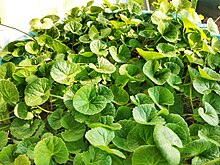Centella asiatica
| Centella asiatica | |
|---|---|

| |
| Scientific classification | |
| Kingdom: | Plantae |
| Clade: | Tracheophytes |
| Clade: | Angiosperms |
| Clade: | Eudicots |
| Clade: | Asterids |
| Order: | Apiales |
| Family: | Apiaceae |
| Genus: | Centella |
| Species: | C. asiatica
|
| Binomial name | |
| Centella asiatica | |
| Synonyms[2] | |
Centella asiatica, commonly known as Indian pennywort, Asiatic pennywort, spadeleaf, coinwort or gotu kola,
Description
Centella grows in
The flowers are white or crimson in color, born in small, rounded bunches (umbels) near the surface of the soil.[2] Each flower is partly enclosed in two green bracts. The hermaphrodite flowers are minute in size, less than 3 mm (0.12 in), with five to six corolla lobes per flower. Each flower bears five stamens and two styles. The fruit are densely reticulate, distinguishing it from species of Hydrocotyle which have smooth, ribbed or warty fruit.[6] The crop matures in three months, and the whole plant, including the roots, is harvested manually. It is a highly invasive plant, rated as "high risk".[2] Centella has numerous common names in its regions of distribution.[2]

Ecology
Centella asiatica is indigenous to the Indian subcontinent (including Sri Lanka), Southeast Asia, parts of Australia, and wetland regions of the Southeastern US.[7][8] Because the plant is aquatic, it is especially sensitive to biological and chemical pollutants in the water, which may be absorbed into the plant. It can be cultivated in drier soils, including sandy loam,[citation needed] as long as they are watered regularly enough (such as in a home garden arrangement).[9]
Composition
Centella contains pentacyclic
Uses
Culinary
In

In Indonesia, the leaves are used for sambai oi peuga-ga, an Aceh type of salad, and is also mixed into asinan in Bogor. In Cambodia, Vietnam and Thailand, this leaf is used for preparing a drink or can be eaten in raw form in salads or cold rolls. In Bangkok, vendors in the Chatuchak Weekend Market sell it alongside coconut, roselle, chrysanthemum, orange and other health drinks. In Malay cuisine it is known as pegaga, and the leaves of this plant are used for ulam, a type of vegetable salad.[2] C. asiatica is widely used in various Indian regional cuisines. In Bangladesh and India (specifically in West Bengal), Centella is called Thankuni Pata and used in various dishes, one of the most appetising of which is the
Traditional medicine
In
Telomerase activation
C. asiatica has been shown to activate
Agricultural use
In the context of
Gallery
-
Emerging flowers
-
Close-up of flower
-
Centella asiatica, India
-
A patch of Centella asiatica or pegaga in Malay
References
- . Retrieved 19 November 2021.
- ^ a b c d e f g h i j k l m "Centella asiatica (Asiatic pennywort)". Invasive Species Compendium, CABI. 22 November 2017. Archived from the original on 23 July 2017. Retrieved 2 January 2018.
- ^ "Centella asiatica". European and Mediterranean Plant Protection Organization (EPPO). Retrieved 23 January 2024.
- ^ "Centella asiatica (L.) Urb". Plants of the World Online. Royal Botanic Gardens, Kew. Retrieved 12 February 2022.
- ^ United States Department of Agriculture. "Plant Profile for Centella asiatica". Retrieved 15 July 2012.
- ^ a b Floridata. "Centella asiatica". Retrieved 15 July 2012.
- ^ "Centella asiatica". Alabama Plant Atlas. Retrieved 17 August 2015.
- ^ "Centella asiatica". Atlas of Florida Vascular Plants. Retrieved 17 August 2015.
- .
- .
- .
- ISBN 9781437723335.
- PMID 33861456.
- ^ "A selection of classic Burmese dishes". Travelfish. Retrieved 2021-01-09.
- PMID 24399761.
- ^ a b c d "Gotu kola". Drugs.com. 23 January 2023. Retrieved 21 September 2023.
- PMID 31485647.
- .





